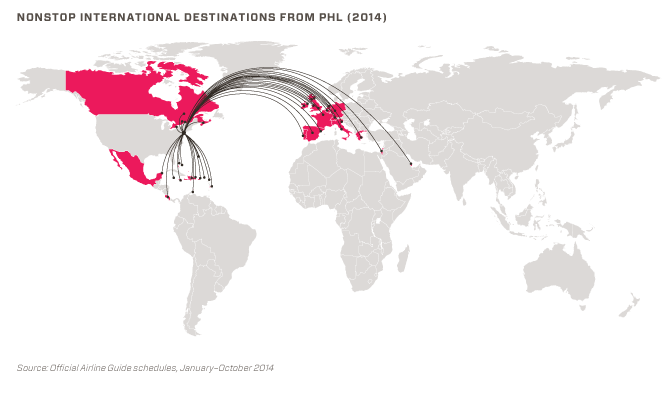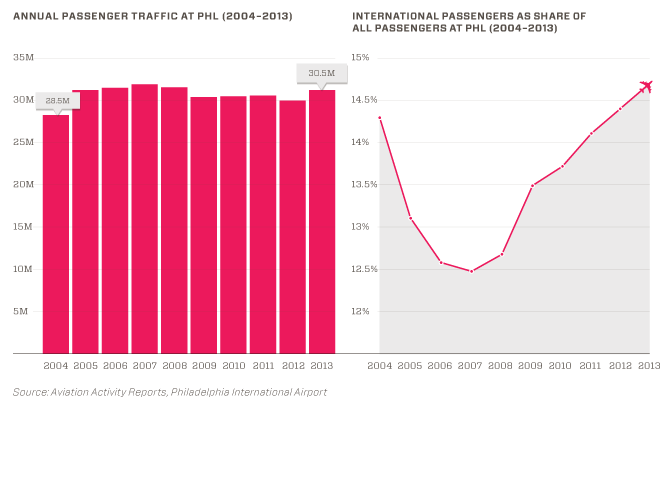Enhancing Greater Philadelphia's Global Reach
As more businesses require access to routes of international trade and travel, convenient and reliable connections to established and emerging markets will greatly influence Greater Philadelphia’s economic competitiveness. The quality of our region’s international connections depends in no small part on the performance of Philadelphia International Airport (PHL).
A variety of recent and ongoing efforts are helping to enhance PHL’s global reach. International passenger traffic through the airport has grown steadily since 2009 – in 2013, PHL served a record 4.5 million international passengers, representing nearly 15% of total passenger traffic at the airport. This growth has occurred despite little growth in overall passenger traffic.
Still, PHL’s global reach remains considerably smaller than that of international airports in peer metros – Philadelphia is the largest US city without nonstop service to Asia, and the region also lacks a nonstop connection to South America.

PHL provides nonstop service to 40 international destinations in 25 countries whose combined GDP of $18 trillion accounts for 25% of world economic output.
Adding International Service
While the direct connection to Asia has proven elusive – US Airways’ 2007 plans for nonstop service to Beijing were placed on hold due to the recession – new connections to the Middle East have helped push PHL’s global reach eastward.
US Airways’ nonstop service to Tel Aviv, instituted in 2009, and Qatar Airways’ route to Doha, which began just this year, have made it easier to get from PHL to Middle Eastern markets as well as points in Asia, as Doha in particular serves as a major connecting hub to India and the Far East.
Efforts to establish the South America connection are ongoing, though progress has been bumpy. Last year, the US Department of Transportation denied US Airways’ bid to begin service between PHL and Sao Paolo in October 2014, meaning that PHL will have to wait until at least 2015 to get its first nonstop connection to the Southern Hemisphere.
The Implications of the Merger
Nevertheless, airport officials are bullish on the potential for continued expansion of PHL’s international connections, due in no small part to the merger between US Airways and American Airlines. Though not guaranteed, the merger's upside for PHL is significant.
With an expanded fleet of long-haul aircraft, the merged airline be in better position to offer flights to Asia and South America from East Coast hubs like PHL. And direct access to the new airline’s larger domestic network should make PHL more attractive to foreign carriers, who take the number and distribution of an airport’s domestic connections into account in choosing international gateways.
So far, the merger's impact on PHL has been positive, with routes to six new US cities added in the months since the deal was approved. This is a promising sign for Greater Philadelphia, which some observers of the merger regard as being at risk of service reductions given its proximity to American Airlines’ hub at JFK. For international service, however, JFK and PHL play very different roles, with the former being primarily a point of origin and destination, and the latter serving largely as a connecting hub for traffic continuing to other US destinations. According to some, this distinction means that there’s plenty of room for growth in service at both airports. And indeed, US Airways has already begun expanding its international offerings at PHL with a new nonstop route to Edinburgh, Scotland. Time will tell if this is a true harbinger of continued growth.
Enhancing Capacity at PHL
Successfully accommodating sustained growth in service, however, will require addressing facility constraints for both travelers and carriers. Airport officials have been working for more than a decade to advance a comprehensive $6.4 billion master plan that includes the expansion of PHL's airfield and capacity and modernization of terminals. This effort reached a major milestone in May 2014, with a settlement between the airport and neighboring Tinicum Township, which had protested against PHL’s plans to acquire township land as part of the expansion plans.
Hurdles remain before the full plan is realized, but with more than $1 billion invested in capital improvements in the past 15 years, international passenger traffic on the rise, and the potential for the merger to expand overseas service from PHL, Greater Philadelphia’s access to the global economy appears poised to grow stronger.

International passenger traffic through PHL has grown steadily since 2009—in 2013, PHL served a record 4.5 million international passengers, representing nearly 15% of total passengers at the airport. This growth has occurred despite little growth in overall traffic at PHL.